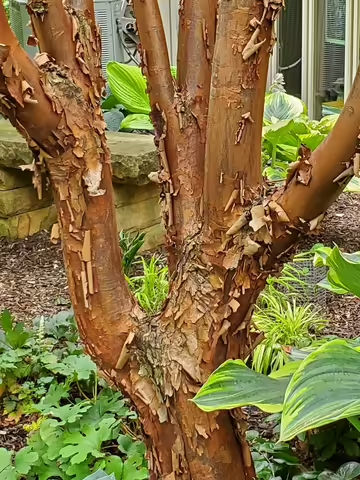URBANA, Ill. – There are plenty of ornamental features to get excited about when it comes to trees, but one interesting feature often gets overlooked: exfoliating bark.
“Exfoliating bark is amazing all year long,” says Andrew Holsinger, University of Illinois Extension horticulture educator. “And some varieties of trees have an amazing color contrast.”
The process of shedding bark, or exfoliating, is normal for some trees. Weather influences this process, including how much of bark is shed in a season.
A word of caution though: peeling or exfoliating bark is not a good sign for trees that don’t naturally exhibit this bark characteristic and can be a sign of problems.
“Bark can be a helpful identification characteristic when identifying trees,” Holsinger says. “Some Illinois native trees with exfoliating bark include sycamore, river birch, bald cypress, ironwood, and eastern red cedar.”
The bark of most young trees is smooth and thin. As the tree matures, the bark becomes thicker, protecting the tree. The outermost layer of bark dies and naturally sloughs off, but with exfoliating trees, this layer peels and reveals the inner layers of bark.
Even in the actively growing state, Holsinger says, the exfoliating bark is a nice feature that can add to the uniqueness of the home or urban landscape.
Exfoliating bark trees provide a great home for bats. Many of bat species native to Illinois use trees with exfoliating bark for summer roosting and maternity colonies.
Some exfoliating bark species are fire resistant. The bark acts somewhat like an insulator protecting the tree.
The following trees have exfoliating bark characteristics and can create a focal point for your landscape:
Bald Cypress (Taxodium distichum), Birch (Betula spp.), Black cherry (Prunus serotina), Dawn redwood (Metasequoia glyplostroboides), Eastern red cedar (Juniperus virginiana), Ironwood/hophornbeam (Ostrya virginiana), Lacebark elm (Ulmus parvifolia), Paperbark maple (Acer griseum), Redbud (Cercis canadensis), Scotch pine (Pinus sylvestris), Shagbark hickory (Carya ovata), Sycamore (Platanus occidentalis) and Zelkova (Zelkova serrata).
SOURCE: Andrew Holsinger, Horticulture Educator, Illinois Extension
ABOUT EXTENSION: Illinois Extension leads public outreach for University of Illinois by translating research into action plans that allow Illinois families, businesses, and community leaders to solve problems, make informed decisions, and adapt to changes and opportunities.
PHOTO ACCESS: The photo in this article is available to download for media use.
